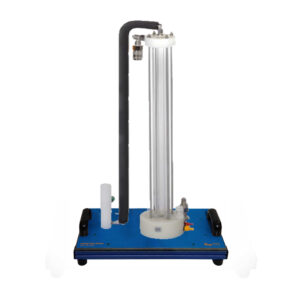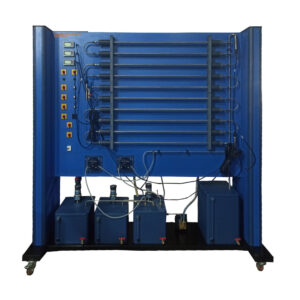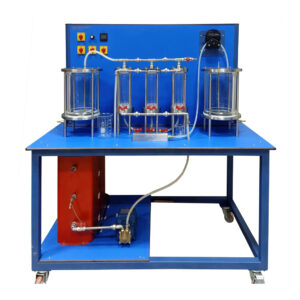Stirred tanks in series are continuous stirred tank reactors that are connected in series, as the name implies. Compared to a single stirred tank reactor, they provide a higher conversion. Stirred tanks in series allow for variable process control because each individual reactor’s temperature and retention duration may be customized. This equipment series that enables research with various reactor types includes the CRE-3305-03. The operation and behavior of stirred tanks in series can be examined in conjunction with the supply unit CRE 3305. The supply unit CRE-3305 is equipped with a heating water circuit, all required connections, pumps, reactant tanks, and a product tank. The supply unit is used to mount the CRE-3305-03, which is secured in place by two pins. The reactor may be quickly and easily connected to the supply unit using quick release connections.
Two pumps from the supply unit transport the reactants into the first reactor during continuous three-stage operation. By ensuring a homogenous mixture, a stirrer extends the amount of time that the reactants are in direct contact. The reactants react to create the product. The mixture of product and unconverted reactants is transferred into two more, similar reactors one after the other after leaving the reactor by an overflow. The supply unit’s additional two peristaltic pumps are used for the intermediate delivery. The transfer takes place in a tank of the supply unit after the third reactor.
By varying the speed of the pumps on the supply unit, the retention duration of the reactants in the reactor can be changed. By measuring the conductivity, the conversions in each reactor are identified. Included is a conductivity/temperature combination sensor. On the supply unit, conductivity and temperature are digitally shown.
Technical Data
3 reactors
- DN 100
- Height: each 250mm
- Reactor capacity approx. 1950mL each
- Material: boro 3.3 glass
Stirrer
- Speed: 300min-1
- Drive: variable speed
- Brushless geared motor
Required: Service Unit for Chemical Rectors CRE-3305.




